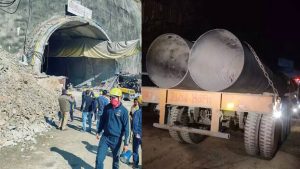 Dehradun: As the rescue operations to evacuate 41 workers trapped in Uttarakhand’s Silkyara tunnel in Uttarkashi district entered the twelfth day on Thursday, it faced a fresh hurdle. Drilling had to be halted after cracks appeared in the platform on which the drilling machine rests, an official said.Following is the timeline of the disaster and the rescue efforts that followed:
Dehradun: As the rescue operations to evacuate 41 workers trapped in Uttarakhand’s Silkyara tunnel in Uttarkashi district entered the twelfth day on Thursday, it faced a fresh hurdle. Drilling had to be halted after cracks appeared in the platform on which the drilling machine rests, an official said.Following is the timeline of the disaster and the rescue efforts that followed:
November 12: The labourers get trapped as portions of the Silkyara-Dandalgaon under-construction tunnel on the Brahmkhal-Yamunotri highway collapse following a landslide at around 5.30 am on the day of Diwali.
Multiple agencies, including the NDRF, SDRF, BRO, project executing agency NHIDCL and ITBP, join the rescue efforts.
Fresh rubble keeps falling from above due to which the debris accumulated in an area of around 30 metres spreads to 60 metres, further complicating the rescue mission.
November 14: Steel pipes of 800- and 900-millimetre diameter are brought to the tunnel site to be inserted through the rubble with the help of an auger machine for horizontal digging.
However, when more rubble falls from the cavity created by the cave-in, two labourers sustain minor injuries.
The trapped workers are supplied food, water, oxygen, electricity and medicines as some of them complain of nausea and headache.
November 15: Dissatisfied with the first drilling machine, the NHIDCL asks for a state-of-the-art auger machine, which is airlifted from Delhi to speed up the operation.
November 16: The drilling machine is assembled and installed. It starts working past midnight.
November 17: Working overnight, the machine drills about 24 metres through the 57-metre stretch rubble stretch by the afternoon and four MS pipes are inserted. The process comes to a halt when the fifth pipe hits an obstacle.
Yet another high-performance auger machine is flown down from Indore to assist in the rescue efforts.
In the evening, the NHIDCL, during the positioning of the fifth pipe, reports that a big cracking sound was heard in the tunnel. An expert warns about the possibility of further collapse in the vicinity and the operation is suspended immediately.
November 18: Drilling does not resume on Saturday as experts feel that the vibrations created by the diesel-driven 1,750-horsepower American auger inside the tunnel might cause more debris to collapse, posing a risk to the lives of the rescue personnel.
Alternative options are explored by a team of officials from the PMO and experts who decide to work on five evacuation plans simultaneously, including vertical drilling through the top of the tunnel to rescue the trapped labourers.
November 19: Drilling remains suspended while Union minister Nitin Gadkari who reviews the rescue operation says boring horizontally with the huge auger machine appeared to be the best bet. He anticipates a breakthrough within two and a half days.
November 20: PM Narendra Modi speaks to Dhami over phone to take stock of the rescue operations at the Silkyara tunnel and stresses on the need to keep their morale up.
Rescuers push through a six-inch-wide pipeline through the rubble, a breakthrough that helps them supply larger quantities of food and other essentials to trapped workers.
However, the team is yet to resume the horizontal drilling that got suspended after a boulder appeared to block the progress of the heavy-duty auger machine.
November 21: Rescuers release the first video of the labourers trapped inside the Silkyara tunnel. The workers, wearing yellow and white helmets, are seen receiving food items sent to them through the pipeline and talking to each other.
Two blasts are set off at the Balkot-end of the under-construction tunnel on the Char Dham route, beginning the process of drilling another tunnel – an alternative to the Silkyara-end option. However, this approach could take up to 40 days, experts said.
The NHIDCL resumed the “horizontal boring operation from the Silkyara end” that involved an auger machine.
November 22: Ambulances are kept on standby and a special ward at a local health centre is made ready.
Horizontal drilling of 800 mm diameter steel pipes reaches about 45 metres with only 12 metres remaining of the around 57-metre debris stretch.
However, in a late evening development, the drilling hits a hurdle when some iron rods come in the way of the auger machine.
November 23: The iron obstruction that had caused a delay of six hours in the drilling is removed in the morning. Rescue operations are resumed.
State government’s nodal officer tells reporters that drilling had progressed by 1.8 metre after Wednesday night’s setback.
Officials say the 48-metre point has been reached by the drill. But boring through the rubble had to be put on hold again apparently after cracks appeared in the platform on which the drilling machine rests.
